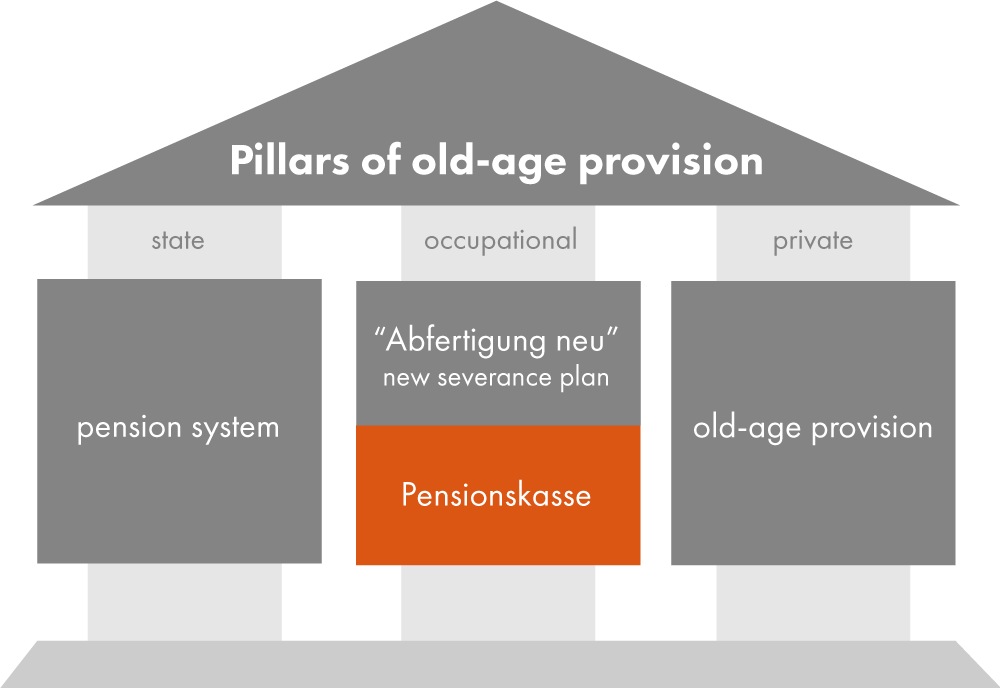Pensionskassen (pension funds) – what you need to know

Pension funds (Pensionskassen) are a form of occupational old-age provision.
Your employer commits to pay in voluntary, regular contributions for your old-age provision. In addition, you may also pay in contributions on a voluntary basis. These funds are managed by the Pensionskassen.
It is important to differentiate between single-employer and multi-employer Pensionskassen. Single-employer Pensionskassen are active for a single employer. Multi-employer Pensionskassen may conduct Pensionskasse business for several employers.
The Pensionskassen invest the funds that are paid in. For this purpose, contributions are bundled into “investment and risk sharing groups”, which each contain at least 1,000 persons. This has the following advantages:
- Balancing out of underwriting risks: the assets of the employees are invested collectively and a balancing of risks is therefore carried out (longevity risk, death risk, occupational disability risk). Longevity risk is the risk that a person lives for longer than expected. Where there is coverage of the risk of death, then insurance covers dying. The Pensionskasse business may also cover invalidity risks.
- Collective investment: As a rule the Pensionskasse follows a separate investment strategy for every investment and risk-sharing group. Pensionskassen are required to ensure the security, profitability and availability of funds. It may be able to diversify risks more cheaply as a result of the larger amounts invested. The risk management function ensures that risks are appropriately managed.
- The assets of an investment and risk-sharing group forms a special fund. In the event of the Pensionskasse’s bankruptcy, its assets are safeguarded. The claims of the beneficiaries are not lost as a result.
Pensionskasse commitments may be either defined benefit-based or performance-based, with combinations of these options also being possible.
- Performance-based commitments: the amount of the pension benefit is fixed. The contributions paid in by the employee fluctuate depending on the yield of the investment of the assets. The employer bears the investment risk and the underwriting risk.
- Contribution-based commitments: the amount of the employer contributions is fixed. The employee bears the investment risk and the underwriting risk.
The Pensionskassen receive compensation for providing their services that are required to be appropriate and customary.
My Pensionskasse
Pension benefits from Pensionskassen exist in the form of:
- life-long old-age pensions
- survivors pensions, which are paid out in accordance with the terms of the contractual agreement.
- Invalidity pensions, which (where contractually agreed) are paid out for the duration of the invalidity
You are considered to be an entitled beneficiary, when you have a claim to future beneficiaries from the Pensionskasse contract.
You are a recipient beneficiary, in the event that you already receive a pension.
I am an entitled beneficiary…
As soon as you become an entitled beneficiary of a Pensionskasse, the employer with the support of the Pensionskasse must inform you about the following:
- How the Pensionskasse works in general
- Scope of performance (e.g. also in case of early old-age pension, occupational disability, etc.)
- The possibility for you to make additional contributions
- How contributions and benefit are treated from a tax perspective
- The website address of the Pensionskasse, where they contain information
The communication sent to you on an annual basis must contain the following information:
- Performance of contribution and capital
- Management fees
- Acquired claims
- Forecast about the expected amount of the benefit
- Investment and performance of the investment and risk-sharing group
You must receive the following information in the event that you leave the company prior to the occurrence of the benefit event:
- Company name, registered office, legal form of the Pensionskasse,
- Name, address, registered office, legal form of the employer
- Reference date, to which the information refers
- Name, gender and date of birth of the beneficiary (entitled);
- The total of the vested amount
- The date on which you left the company
- Options for reimbursement of the vested amount
- Pre-printed form for administrative processing
- In the case of a settlement payment the amount of income tax
In the case that you terminate your employment relationship prior to the occurrence of the benefit event then your entitlement remains intact, this is known as the vested amount. The sum of the vested amount may be calculated using actuarial principles.
Your options after having terminated your employment relationship
- The vested amount may remain in the Pensionskasse and may be topped up with contributions that you make yourself.
- The vested amount may be transferred to another severance and retirement provision facility, for example the one that your new employer is a member of.
- In the case that you permanently change your place of work to somewhere overseas, it is possible to transfer the vested amount to a foreign old-age provision facility.
The pension capital that has been paid in is only legally permissible under the followingconditions:
- the employment relationship must have already been terminated.
- any applicable contractually agreed vesting period (max. 3 years) must have expired.
- The paid-in capital from contributions made by the employer and the employee shall not be allowed to exceed the severance limit of EUR 12,600 (as of 2019).
I am eligible for benefits…
As soon as you are eligible for benefits, you must receive the following information:
- The total of the acquired claim
- Methods of payment
The annual statement of account must contain the following information:
- Capital performance
- Management fees
- Investment and performance of the investment and risk-sharing group
In the case that the amount of your pension benefit changes, then you much receive a schematic statement about the individual causes.
Why does the amount of my pension benefit vary?
The following explainer video is only available in German.